Geomorphic Approaches to Estimate Short-Term Erosion Rates: An Example from Valmarecchia River System (Northern Apennines, Italy)
Abstract
1. Introduction and Study Area
2. Geological and Geomorphological Settings
- -
- AQV (Acquaviva Formation), coarse sandstones with pebbles scattered in irregular layers, generally massive and thick and in laterally discontinuous banks. Subordinate are the conglomerate levels, generally lenticular. Lower Tortonian—Messinian;
- -
- AVR (Argille Varicolori della Valmarecchia Formation): AVRa (Arenaceous lithofacies), AVRb (calcareous-arenaceous lithofacies), chaotic polychromatic clays with intercalated levels of limestone, calcilutites, fine sandstones, siltstones, black clayey marls and marls. Lower Cretaceous—lower Eocene;
- -
- FMA (Marnoso-Arenacea Romagnola Formation), monotonous succession of turbidite beds with bipartite sandstone-pelite layers and intercalations of marly hemipelagites. Upper Burdigalian—lower Messinian;
- -
- GHL (Ghioli di Letto Formation), silty-marly clays with thin layers of siltytic sandstones and, in the upper part, bituminous pelites and carbon levels; rare layers of calcilutites and marly limestones. Clayey-marly hemipelagites and slumping levels several meters thick are also present. Tortonian—Messinian;
- -
- MFU (Monte Fumaiolo Formation), ungraded hybrid sandstones with medium-thin stratification, concave-convex, at times with cross-bedding megaripples, tapering upwards. Upper Burdigalian—Serravallian;
- -
- MLL (Monte Morello Formation), alternation of limestones and marly limestones, turbidite limestones and marls, and MLLa (Casa Nuova or Marne Rosate lithofacies), marls and marly limestones alternating with dark and polychrome clays. Mid-lower Eocene;
- -
- SIL (Sillano Formation), alternation of limestones and mudstones, at times polychrome, especially in the basal part, where they become predominant. Locally calcareous marls are present. The carbonate portion is represented by fine-grained turbid limestones, calcilutites and marly limestones. Upper Cretaceous—lower Eocene;
- -
- SMN (San Marino Formation), organogenic limestones and calcarenites rich in bioclasts. Sometimes, the limestones become silty-sandy and glauconitic, in particular towards the top of the formation. SMN1 (base member), massive biocalcarenites, calcirudites and polygenic conglomerates, sometimes with intercalations of more arenaceous layers with fossil traces, and SMN2 (stratified limestones member), very thick layers of biocalcarenites. Towards the top, the grain size decreases and the non-carbonate component increases, mostly given by glauconitic granules. Upper Burdigalian—lower Langhian;
- -
- RAA (Villa a Radda Formation), acicular fractured clays alternating with layers of sandstone with carbonatic cement; thin layers of calcisiltites and limestones are rarely present. Upper Cretaceous p.p.—lower Eocene p.p.
3. Materials and Methods
Geomorphic Analysis and Short-Term Erosion Rates Calculation
- -
- Nu = number of river channels of u order [31];
- -
- Ndu = number of river channels of u order that merge into river channels of u + 1 order;
- -
- A = area of the basin (km2);
- -
- ∑L = total sum of river channel lengths (km);
- -
- D = drainage density = ∑L/A (km/km2) [32];
- -
- L = main channel length (km);
- -
- Rf = shape factor = A/L2;
- -
- Rc = circularity ratio = 4πA/P2 [33];
- -
- Ru = uniformity index or compactness coefficient = 0.2841 × P/A0.5 [34];
- -
- Ra = elongation ratio = 2/Lb × (A/π)0.5 [35];
- -
- S = sinuosity index = D/(Nu/A);
- -
- P = perimeter of the basin (km);
- -
- F1 = first order channels frequency = N1/A;
- -
- Rb = bifurcation ratio = Nu/Nu+1;
- -
- Rbd = direct bifurcation ratio = Ndu/Nu+1;
- -
- R = bifurcation index, R = Rb − Rbd;
- -
- Ga = hierarchical anomaly number, the smallest number of first order streams necessary to make the drainage net perfectly conservative [36]; Ga = ;
- -
- Δa = hierarchical anomaly index = Ga/N1;
- -
- ga = hierarchical anomaly density = Ga/A.
4. Results
4.1. Geomorphological Maps
4.2. Geomorphic Analysis and Short-Term Erosion Rates
5. Discussion and Final Remarks
Author Contributions
Funding
Acknowledgments
Conflicts of Interest
References
- Ciccacci, S.; Fredi, P.; Palmieri, E.L.; Pugliese, F. Contributo dell’analisi geomorfica quantitativa alla valutazione dell’entità dell’erosione nei bacini fluviali. Boll. Soc. Geol. It. 1980, 99, 455–516. [Google Scholar]
- Ciccacci, S.; Fredi, P.; Palmieri, E.L.; Pugliese, F. Indirect evaluation of erosion entity in drainage basins through geomorphic, climatic and hydrological parameters. Int. Geomorphol. 1986, 2, 33–48. [Google Scholar]
- Del Monte, M.; Fredi, P.; Palmieri, E.L.; Marini, R. Contribution of quantitative geomorphic analysis to the evaluation of geomorphological hazards. In Applied Geomorphology: Theory and Practice; Allison, R.J., Ed.; J. Wiley & Sons: Hoboken, NJ, USA, 2002; pp. 335–358. [Google Scholar]
- Del Monte, M. Caratteristiche morfometriche e morfodinamiche dell’alto bacino del Fiume Orcia (Toscana meridionale). Congr. Geogr. It. 2003, Atti XXVIII, 1938–1975. [Google Scholar]
- Della Seta, M.; Del Monte, M.; Fredi, P.; Palmieri, E.L. Direct and indirect evaluation of denudation rates in Central Italy. Catena 2007, 71, 21–30. [Google Scholar] [CrossRef]
- Avena, G.C.; Giuliano, G.; Palmieri, E.L. Sulla valutazione quantitativa della gerarchizzazione ed evoluzione dei reticoli fluviali. Boll. Soc. Geol. It. 1967, 86, 781–796. [Google Scholar]
- Bonarelli, G. Interpretazione strutturale della regione feltresca. Boll. Soc. Geol. It. 1929, 48, 314–316. [Google Scholar]
- Capozzi, R.; Landuzzi, A.; Negri, A.; Vai, G. Stili deformativi ed evoluzione tettonica della successione neogenica romagnola. Stud. Geol. Camer. 1991, 1, 261–278. [Google Scholar]
- Cerrina Feroni, A.; Ghiselli, F.; Leoni, L.; Martelli, L.; Martinelli, P.; Ottria, G.; Sarti, G. L’assenza delle Liguridi nell’Appennino romagnolo: Relazioni tra il sollevamento quaternario e implicazioni strutturali. Quaternario 1997, 10, 371–376. [Google Scholar]
- Cerrina Feroni, A.; Ottria, G.; Martinelli, P.; Martelli, L. Carta Geologico-Strutturale dell’Appennino Emiliano-Romagnolo. Scala 1:250.000, Regione Emilia-Romagna; Consiglio Nazionale delle Ricerche: Bologna, Italy, 2002. [Google Scholar]
- Conti, S.; Fregni, P.; Gelmin, R. L’età della messa in posto della coltre della Val Marecchia. Implicazioni paleogeografiche e strutturali. Mem. Soc. Geol. It. 1987, 39, 143–164. [Google Scholar]
- Ricci Lucchi, F. The Oligocene to recent foreland basins of the northern Apennines. In International Association of Sedimentologists Special Publications; Allen, P.A., Homewood, P., Eds.; Blackwell Scientific Publications: Oxford, UK, 1986; Volume 8, pp. 105–139. [Google Scholar]
- Selli, R. Il bacino del Metauro. Descrizione geologica, risorse minerarie, idrogeologia. Giornal. Geol. 1954, 24, 1–214. [Google Scholar]
- Vai, G.; Castellarin, A. Correlazione sinottica delle unità stratigrafiche nell’Appennino settentrionale. Stud. Geol. Camer. 1992, Spec. Vol. 1992/2, 171–185. [Google Scholar]
- Zattin, M.; Picotti, V.; Zuffa, G.G. Fission-track reconstruction of the front of the northern Apennine thrust wedge and overlying Ligurian unit. Am. J. Sci. 2002, 302, 346–379. [Google Scholar] [CrossRef]
- Carmignani, L.; Conti, P.; Cornamusini, G.; Meccheri, M. The internal Northern Apennines, the Northern Tyrrhenian Sea and the Sardinia-Corsica Block. In Geology of Italy. Special Volume of the Italian Geological Society for the IGC Florence; Crescenti, S.U., D’Offizi, S., Merlino Sacchi, L., Eds.; Società Geologica Italiana, Roma: Rome, Italy, 2004; pp. 59–77. [Google Scholar]
- Carmignani, L.; Conti, P.; Cornamusini, G.; Pirro, A. Geological map of Tuscany (Italy). J. Maps 2013, 9, 487–497. [Google Scholar] [CrossRef]
- Cornamusini, G.; Ielpi, A.; Bonciani, F.; Callegari, I.; Conti, P. Geological map of the Chianti Mts (Northern Apennines, Italy). J. Maps 2012, 8, 22–32. [Google Scholar] [CrossRef]
- Conti, S. Geologia dell’Appennino marchigiano-romagnolo tra le valli del Savio e del Foglia. Note illustrative alla carta geologica a scala 1:50,000. Boll. Soc. Geol. It. 1989, 108, 453–490. [Google Scholar]
- Cornamusini, G.; Conti, P.; Bonciani, F.; Callegari, I.; Martelli, L. Geology of the ‘Coltre della Val Marecchia’ (Romagna-Marche Northern Apennines, Italy). J. Maps 2017, 13, 207–218. [Google Scholar] [CrossRef]
- Cornamusini, G.; Martelli, L.; Conti, P.; Pieruccini, P.; Benini, A.; Bonciani, F.; Carmignani, L. Note Illustrative Della Carta Geologica d’Italia alla Scala 1: 50.000; Foglio 266-Mercato Saraceno; Servizio Geologico d’Italia: Roma, Italy, 2009; p. 124. [Google Scholar]
- Guerra, C.; Nesci, O. L’analisi del paesaggio storico come strumento per la comprensione dell’evoluzione geomorfologica e ambientale del territorio. Alcuni casi studio nel Montefeltro. Geol. Emilia Romagna 2012, 48–49, 7–16. [Google Scholar]
- Casagli, N. Meccanismi di Instabilità Indotti dal Contrasto di Competenza in Ammassi Rocciosi su un Substrato Deformabile. Ph.D. Thesis, University of Milan, Milan, Italy, 1994. [Google Scholar]
- Lucchi, F. Turbidites on foreland and on-thrust basins of the northern Apennines. Palaeogeogr. Palaeoclimatol. Palaeoecol. 1990, 77, 51–66. [Google Scholar] [CrossRef]
- Cyr, A.J.; Granger, D.E. Dynamic equilibrium among erosion, river incision, and coastal uplift in the northern and central Apennines, Italy. Geology 2008, 36, 103–106. [Google Scholar] [CrossRef]
- Coltorti, M.; Pieruccini, P. A late Lower Pliocene planation surface across the Italian Peninsula: A key tool in neotectonic studies. J. Geodyn. 2000, 29, 323–328. [Google Scholar] [CrossRef]
- Strahler, A.N. Quantitative analysis of watershed geomorphology. Trans. Am. Geoph. Un. 1957, 38, 913–920. [Google Scholar] [CrossRef]
- Lazzari, M.; Schiattarella, M. Confronto tra tassi di erosione fluviale e da franosità in alta Val d’Agri (Appennino meridionale). In Studi di Base Sull’Interazione tra Clima, Tettonica e Morfoevoluzione in Italia Meridionale Durante il Quaternario; Boenzi, F., Capolongo, D., Giano, S.I., Schiattarella, M., Eds.; Dibuono Edizioni, Villa d’Agri (PZ): Marsicovetere, Italy, 2008; pp. 105–114. [Google Scholar]
- Lazzari, M.; Schiattarella, M. Estimating long to short-term erosion rates of fluvial vs mass movement processes: An example from the axial zone of the southern Italian Apennines. It. J. Agron. 2010, 5, 57–66. [Google Scholar] [CrossRef]
- Schiattarella, M.; Beneduce, P.; Pascale, S. Comparazione tra i tassi di erosione e sollevamento dell’Appennino Lucano: L’esempio della Fiumara di Tito e Picerno. Boll. A.I.C. 2004, 121–122, 367–385. [Google Scholar]
- Horton, R.E. Erosional development of streams and their drainage basins; hydrophysical approach to quantitative morphology. Geol. Soc. Am. Bull. 1945, 56, 275–370. [Google Scholar] [CrossRef]
- Horton, R.E. Drainage Basin Characteristics. Trans. Am. Geophys. Union 1932, 13, 350–361. [Google Scholar] [CrossRef]
- Miller, V.C. A quantitative geomorphic study of drainage basin characteristics in the clinch mountain area. In Technical Report 3; Department of Geology, Columbia University: New York, NY, USA, 1953. [Google Scholar]
- Gravelius, H. Grundriß der gesamten Gewasserkunde, Band 1: Flußkunde. Compend. Hydrol. 1914, I, 265–278. [Google Scholar]
- Schumm, S.A. Evolution of Drainage Systems & Slopes in Badlands at Perth Anboy, New Jersey. Bull. Geol. Soc. Am. 1956, 67, 597–646. [Google Scholar] [CrossRef]
- Melton, M.A. An Analysis of the Relation among Elements of Climate, Surface Properties, and Geomorphology; Department of Geology, Columbia University: New York, NY, USA, 1957. [Google Scholar] [CrossRef]
- Ciccacci, S.; Fredi, P.; Lupia Palmieri, E. Quantitative expression of climatic and geomorphic factors affecting erosional processes: Indirect determination of the amount of erosion in drainage basins in Italy. An approach. In Proceedings of the Polish-Italian Seminar “Superficial Mass Movement in Mountain Regions”, Warszawa, Poland, 17–19 May 1979; pp. 76–89. [Google Scholar]
- Tarquini, S.; Isola, I.; Favalli, M.; Mazzarini, F.; Bisson, M.; Pareschi, M.T.; Boschi, E. TINITALY/01: A new triangular irregular network of Italy. Ann. Geophys. 2007, 50, 407–425. [Google Scholar]
- Zingaro, M.; Refice, A.; Giachetta, E.; D’Addabbo, A.; Lovergine, F.; De Pasquale, V.; Pepe, G.; Brandolini, P.; Cevasco, A.; Capolongo, D. Sediment mobility and connectivity in a catchment: A new mapping approach. Sci. Total Environ. 2019, 672, 763–775. [Google Scholar] [CrossRef]
- Brandolini, P.; Pepe, G.; Capolongo, D.; Cappadonia, C.; Cevasco, A.; Conoscenti, C.; Marsico, A.; Vergari, F.; Del Monte, M. Hillslope degradation in representative Italian areas: Just soil erosion risk or opportunity for development? Land Degrad. Dev. 2018, 29, 3050–3068. [Google Scholar] [CrossRef]
- Brandolini, P.; Cappadonia, C.; Luberti, G.M.; Donadio, C.; Stamatopoulos, L.; Di Maggio, C.; Faccini, F.; Stanislao, C.; Vergari, F.; Paliaga, G.; et al. Geomorphology of the Anthropocene in Mediterranean urban areas. Progr. Phys. Geogr. 2020, 44, 461–494. [Google Scholar] [CrossRef]
- Smith, K.G. Standards for grading textures of erosional topography. Am. J. Sci. 1950, 248, 655–668. [Google Scholar] [CrossRef]
- Della Seta, M.; Del Monte, M.; Fredi, P.; Palmieri, E.L. Space–time variability of denudation rates at the catchment and hillslope scales on the Tyrrhenian side of Central Italy. Geomorphology 2009, 107, 161–177. [Google Scholar] [CrossRef]
- Ciccacci, S.; D’Alessandro, L.; Fredi, P.; Lupia Palmieri, E. Contributo dell’analisi geomorfica quantitativa allo studio dei processi di denudazione nel bacino idrografico del Torrente Paglia (Toscana meridionale–Lazio settentrionale). Geogr. Fis. Din. Quat. 1988, 1, 171–188. [Google Scholar]
- Gioia, D.; Martino, C.; Schiattarella, M. Long- to short-term denudation rates in the southern Apennines: Geomorphological markers and chronological constraints. Geol. Carpath. 2011, 62, 27–41. [Google Scholar] [CrossRef]
- Bartolini, C. An overview of Pliocene to present-day uplift and denudation rates in the Northern Apennine. Geol. Soc. London Spec. Publ. 1999, 162, 119–125. [Google Scholar] [CrossRef]
- Amato, A.; Aucelli, P.P.C.; Cinque, A. The long-term denudation rate in the Southern Apennines Chain (Italy): A GIS-aided estimation of the rock volumes eroded since middle Pleistocene time. Quat. Int. 2003, 101, 3–11. [Google Scholar] [CrossRef]
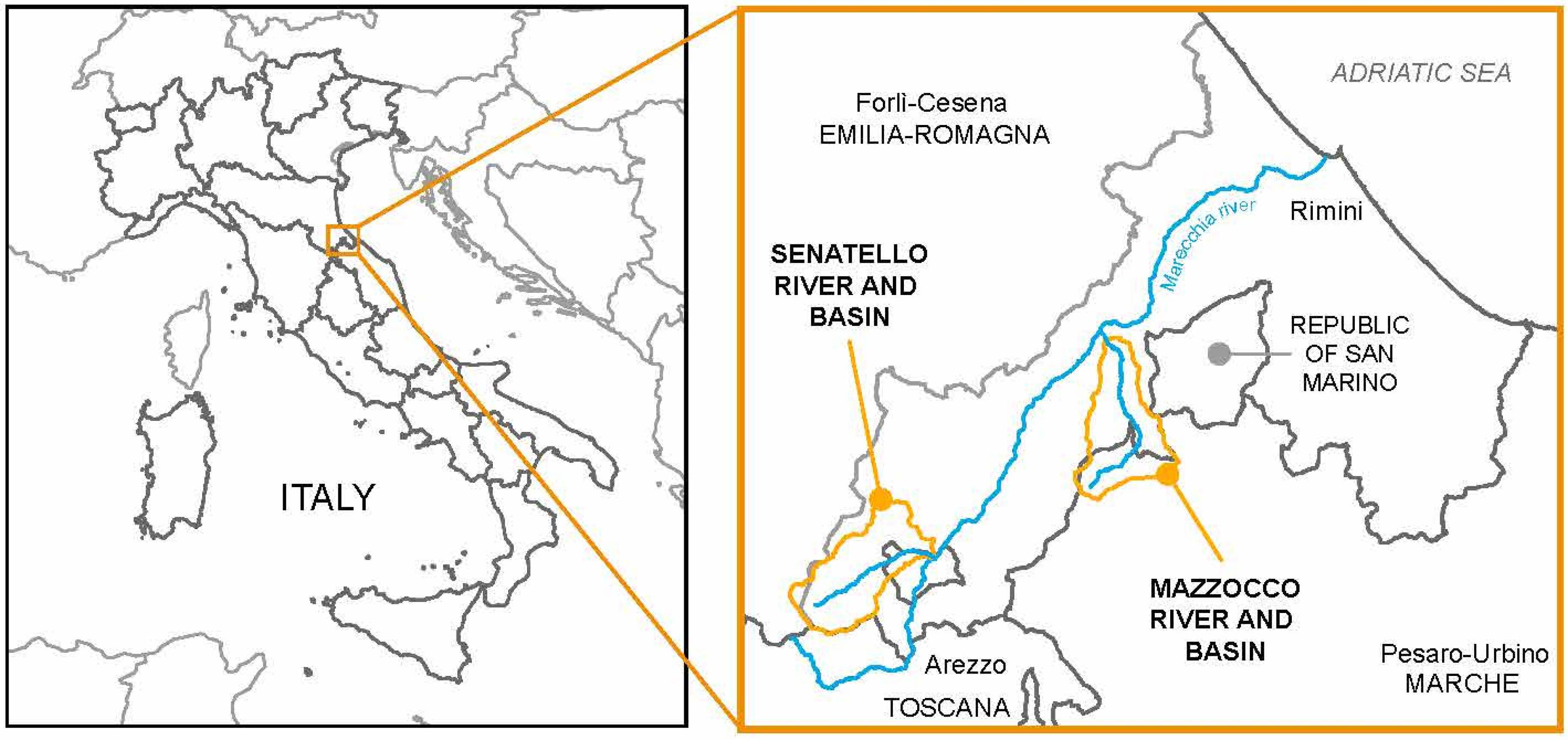
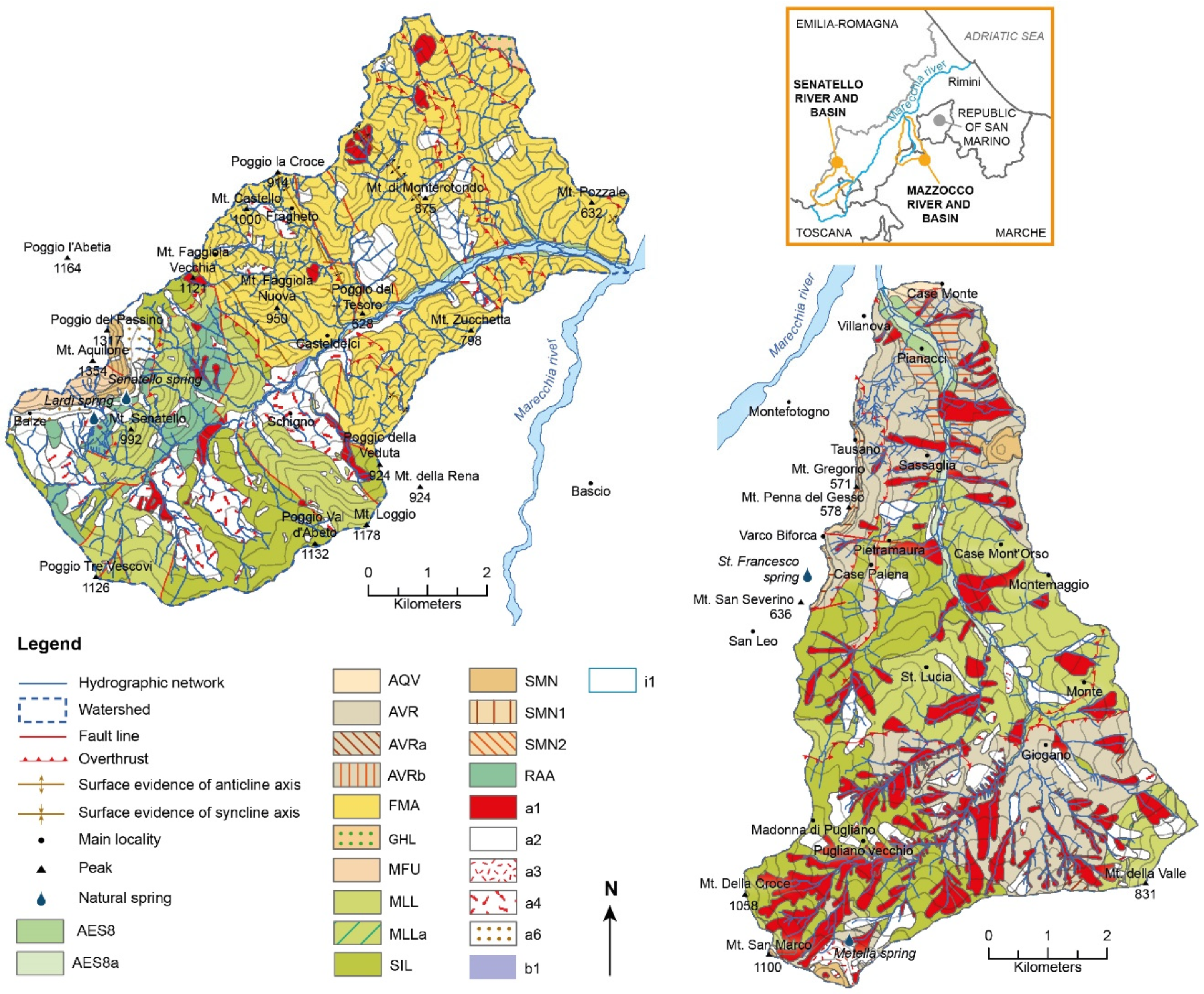
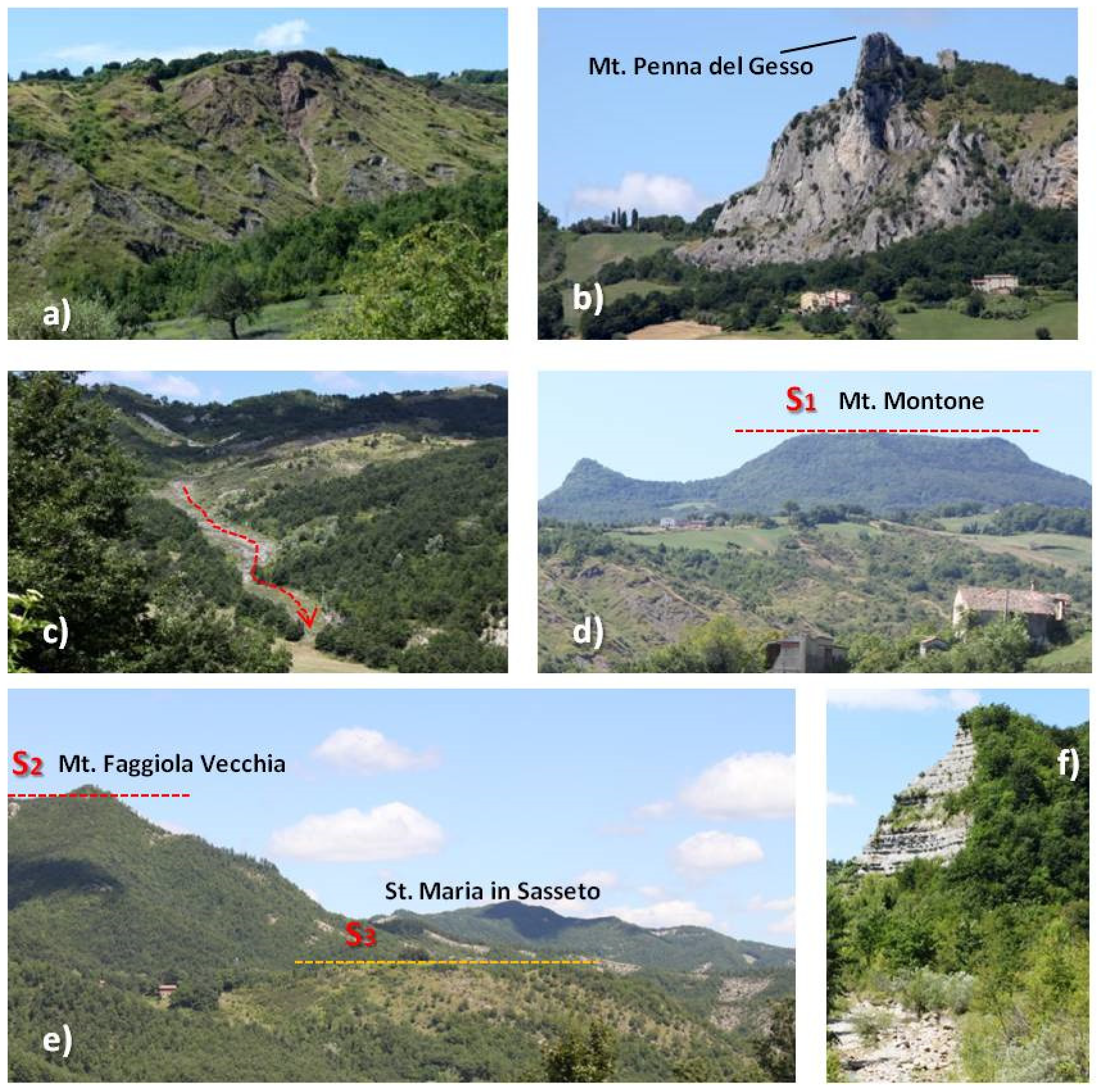


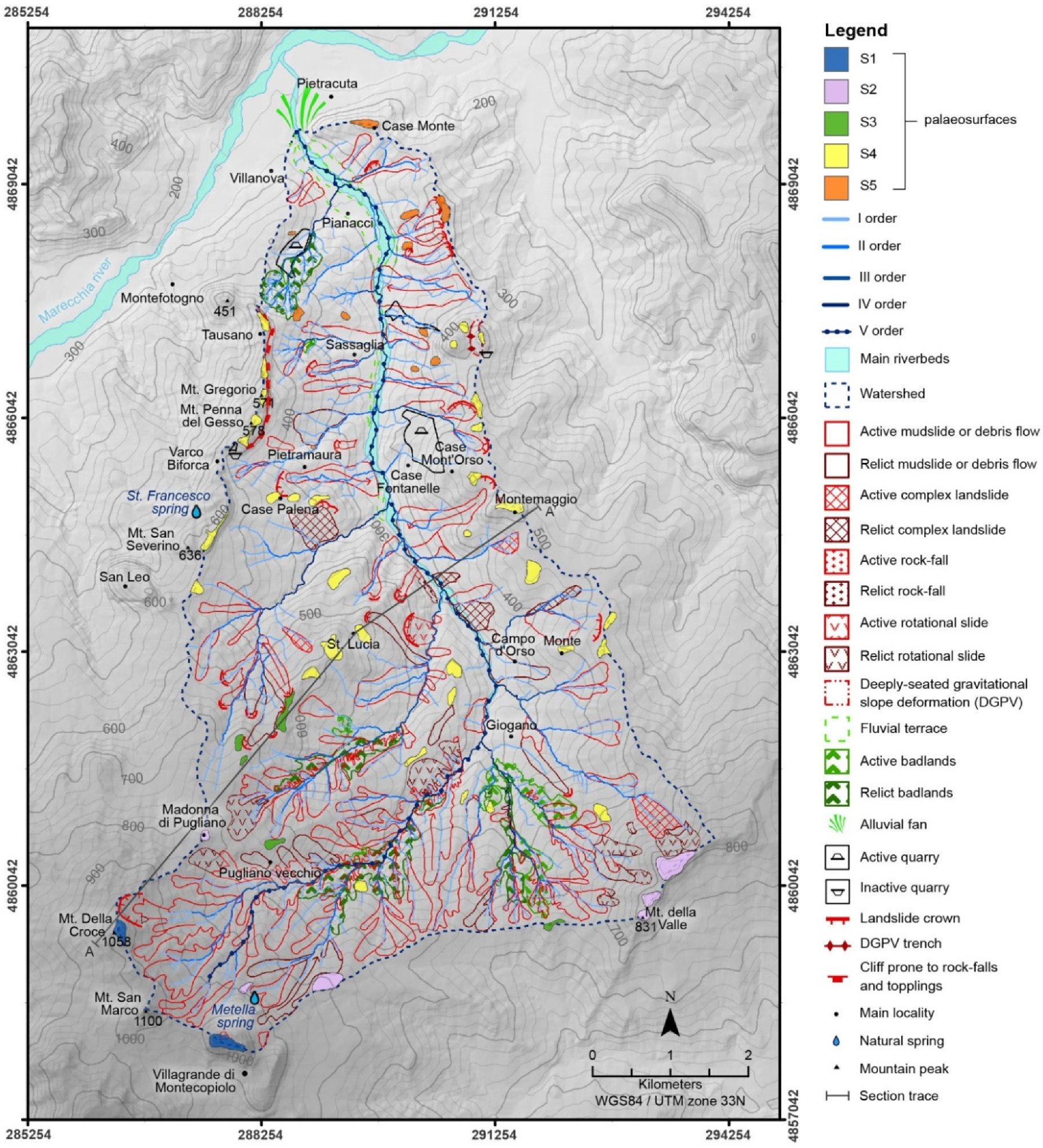
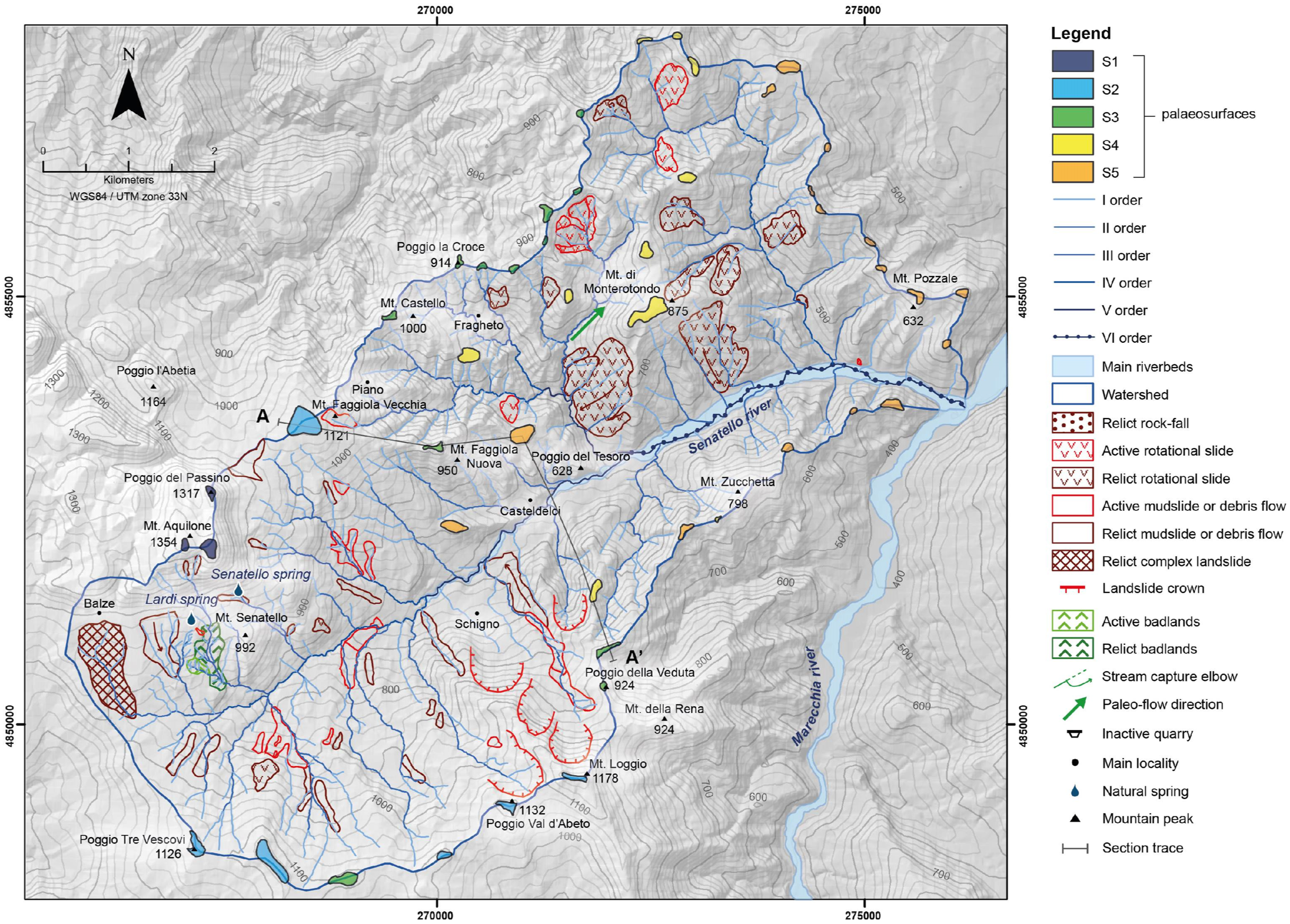
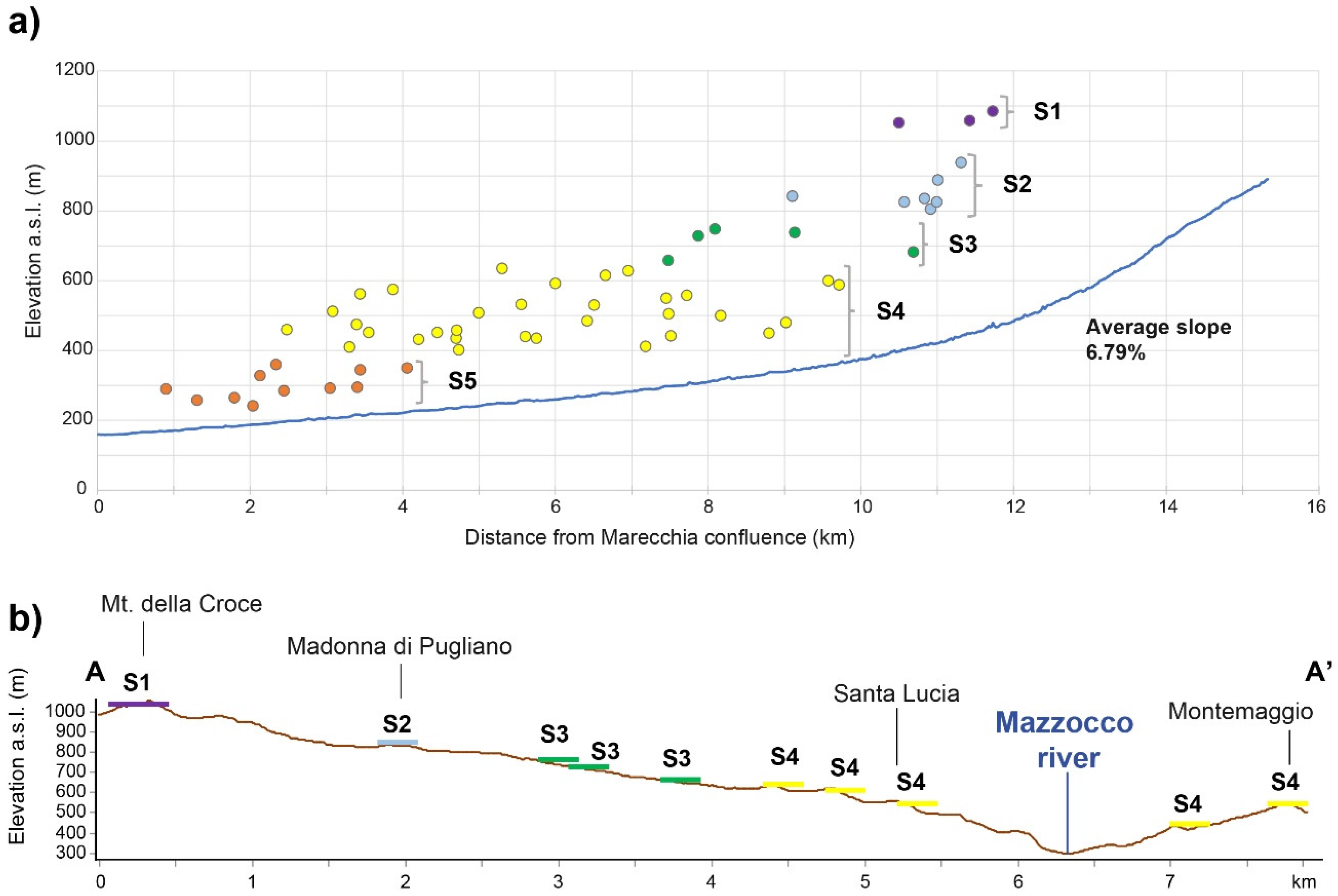
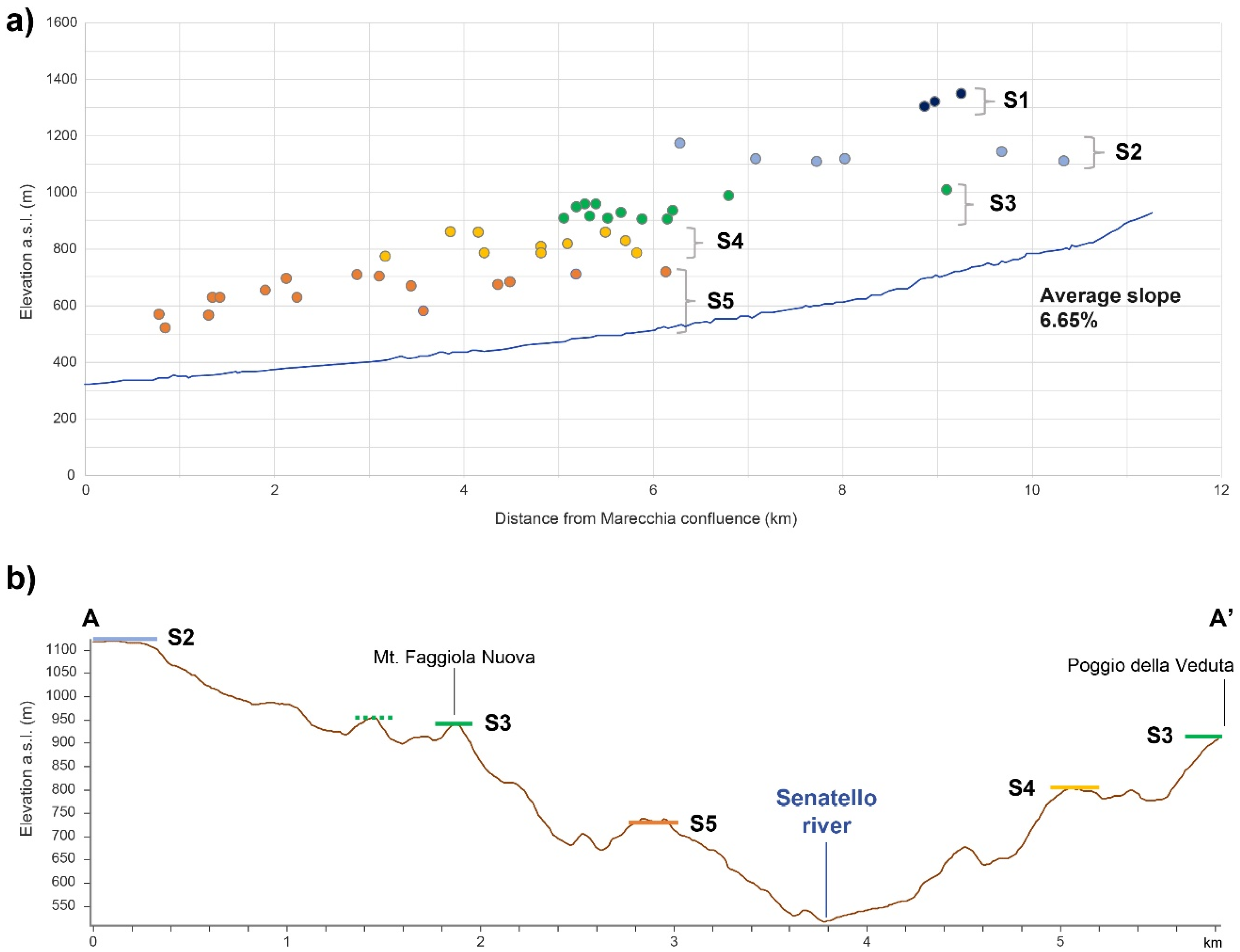
| Geological Formation | Abbr. | Lythotype | γs gr/cm3 |
|---|---|---|---|
| Acquaviva Formation | AQV | Coarse sandstones with pebbles. Subordinate are the conglomerate levels, generally lenticular. | 2.4 |
| Argille Varicolori Formation | AVR | Chaotic polychromatic clays with intercalated levels of limestone, calcilutites, fine sandstones, siltstones, black clayey marls and marls. | 2.3 |
| Marnoso-Arenacea Formation | FMA | Turbidite sandstone-pelite layers and intercalations of marly hemipelagites. | 2.7 |
| Ghioli di letto Formation | GHL | Silty-marly clays with thin layers of siltytic sandstones and, in the upper part, bituminous mudstones and carbon levels. | 2.3 |
| Monte Fumaiolo Formation | MFU | Ungraded hybrid sandstones with medium-thin stratification. | 2.7 |
| Monte Morello Formation | MLL | Alternation of limestones and marly limestones, turbidite limestones and marls. | 2.7 |
| Monte Morello Formation—Case Nuove or Marne Rosate lithofacies | MLLa | Marls and marly limestones alternating with dark and polychrome clays. | 2.4 |
| Sillano Formation | SIL | Alternation of limestones and mudstones. Locally calcareous marls are present. | 2.4 |
| San Marino Formation | SMN | Organogenic limestones and calcarenites rich in bioclasts. | 2.7 |
| San Marino Formation—base Member | SMN1 | Massive biocalcarenites, calcirudites and polygenic conglomerates, sometimes with intercalations of more arenaceous layers. | 2.5 |
| San Marino Formation—stratified limestones Member | SMN2 | Very thick layers of biocalcarenites. | 2.4 |
| Villa a Radda Formation | RAA | Clays alternating with layers of sandstone with carbonatic cement. | 2.4 |
| Mazzocco | Nu | Ndu | Rb | Senatello | Nu | Ndu | Rb |
|---|---|---|---|---|---|---|---|
| 1st order | 323 | 241 | 1st order | 334 | 256 | ||
| 4.31 | 4.02 | ||||||
| 2nd | 75 | 47 | 2nd | 83 | 56 | ||
| 3.95 | 4.37 | ||||||
| 3rd | 19 | 14 | 3rd | 19 | 15 | ||
| 3.17 | 3.80 | ||||||
| 4th | 6 | 6 | 4th | 5 | 4 | ||
| 6 | 2.50 | ||||||
| 5th | 1 | 5th | 2 | 2 | |||
| 6th | 1 | ||||||
| Total | 424 | 398 | Total | 443 | 333 | ||
| Mean value | 4.36 | Mean value | 3.67 |
| Mazzocco | Anomalies Number | Anomalous Frequences | ||||||
|---|---|---|---|---|---|---|---|---|
| N 1–3 | N 1–4 | N 1–5 | F 1–3 | F 1–4 | F 1–5 | |||
| 32 | 30 | 19 | 32 | 90 | 133 | |||
| N 2–4 | N 2–5 | F 2–4 | F 2–5 | |||||
| 14 | 13 | 28 | 78 | |||||
| N 3–5 | F 3–5 | |||||||
| 5 | 20 | |||||||
| Senatello | Anomalies Number | Anomalous Frequences | ||||||
| N 1–3 | N 1–4 | N 1–5 | N 1–6 | F 1–3 | F 1–4 | F 1–5 | F 1–6 | |
| 44 | 18 | 3 | 7 | 44 | 54 | 21 | 105 | |
| N 2–4 | N 2–5 | N 2–6 | F 2–4 | F 2–5 | F 2–6 | |||
| 11 | 8 | 6 | 22 | 48 | 84 | |||
| N 3–5 | N 3–6 | F 3–5 | F 3–6 | |||||
| 2 | 2 | 8 | 16 | |||||
| N 4–6 | F 4–6 | |||||||
| 1 | 8 | |||||||
| Basins | Nu | Ndu | A | ∑L | D | L | Rf | Rc | Ru | Ra | S |
|---|---|---|---|---|---|---|---|---|---|---|---|
| Mazzocco | 424 | 308 | 46.6 | 171 | 3.67 | 13.6 | 0.25 | 0.50 | 1.43 | 0.57 | 0.40 |
| Senatello | 444 | 331 | 48.5 | 186.9 | 3.85 | 11.2 | 0.39 | 0.62 | 1.43 | 0.70 | 0.42 |
| P | F1 | Rb | Rbd | R | Ga | Δa | ga | log Tu | Tu | Ta | |
| Mazzocco | 34.5 | 6.93 | 4.36 | 3.51 | 0.85 | 381 | 1.18 | 8.18 | 2.71 | 509.75 | 0.20 |
| Senatello | 35.3 | 6.89 | 3.67 | 2.76 | 0.92 | 410 | 1.23 | 8.45 | 2.75 | 562.53 | 0.22 |
© 2020 by the authors. Licensee MDPI, Basel, Switzerland. This article is an open access article distributed under the terms and conditions of the Creative Commons Attribution (CC BY) license (http://creativecommons.org/licenses/by/4.0/).
Share and Cite
Guerra, V.; Lazzari, M. Geomorphic Approaches to Estimate Short-Term Erosion Rates: An Example from Valmarecchia River System (Northern Apennines, Italy). Water 2020, 12, 2535. https://doi.org/10.3390/w12092535
Guerra V, Lazzari M. Geomorphic Approaches to Estimate Short-Term Erosion Rates: An Example from Valmarecchia River System (Northern Apennines, Italy). Water. 2020; 12(9):2535. https://doi.org/10.3390/w12092535
Chicago/Turabian StyleGuerra, Veronica, and Maurizio Lazzari. 2020. "Geomorphic Approaches to Estimate Short-Term Erosion Rates: An Example from Valmarecchia River System (Northern Apennines, Italy)" Water 12, no. 9: 2535. https://doi.org/10.3390/w12092535
APA StyleGuerra, V., & Lazzari, M. (2020). Geomorphic Approaches to Estimate Short-Term Erosion Rates: An Example from Valmarecchia River System (Northern Apennines, Italy). Water, 12(9), 2535. https://doi.org/10.3390/w12092535






